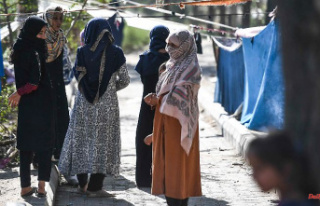With a whole wave of kamikaze drones, Russia is attacking civilian targets in Ukraine at night and in the morning. The drones from Iran pose great challenges for the defenders, but could lose some of their terror in the foreseeable future.
The third week of October also begins for Ukraine with massive attacks on the entire country. The Russian occupiers are firing at targets far from the front, at power plants, other utilities and residential areas. Nobody should be able to feel safe in the non-occupied part of Ukraine. However, because Russia has still not established air superiority eight months after the start of the war and Ukraine has been able to organize more and more air defense systems, Russia's air force does not feel so safe over Ukrainian soil. When Russia isn't firing missiles at the country, it relies primarily on drones - especially so-called kamikaze drones, which are unanimously believed to be Iranian-made. Even if Tehran denies the deliveries - and thus the active partisanship for Russia's war of aggression.
In fact, Kamikaze drones of the Shahed-136 type have been appearing over Ukraine for weeks. During attacks on the port city of Odessa, the appearance of the loud aerial devices in the sky alone was enough to terrorize the population. According to Mayor Vitali Klitschko, a drone hit a residential building on Monday in Kyiv. Pictures show a destroyed building, which the drone is said to have hit and exploded. This attack was obviously aimed at the civilian population and had nothing to do with an attack on military targets. But the drones are also a military factor: the Ukrainian military has repeatedly reported losses of guns, armored vehicles and other military equipment.
The country has therefore massively upgraded: with anti-drone guns such as the "Sky Wiper" EDM4S, with the use of air defense against the smaller drones and even the Ukrainian air force is said to have shot down drones. At least two Russian drones were said to have been shot down by Ukrainian planes on Monday morning. According to their own statements, the Ukrainian army has taken down a total of 37 Russian drones from the sky since Sunday evening. According to a spokesman for the Ukrainian Air Force, around 85 to 86 percent of the drones were used in the recent attacks. That is a "pretty good result". But: The use of expensive Western anti-aircraft ammunition against small, comparatively cheap drones is not very efficient.
Not all drones deployed by Russia are Iranian kamikaze drones. Moscow also has reconnaissance and armed drones of its own production. But without Western-made chips, to which Russia has little access due to sanctions, the production of high-end products is difficult. And this is where the Iranian devices come into play, because the country is used to dealing with sanctions and routinely produces armaments with technology freely available on the world markets. As "Military Factory" explains, Shahed-136 are warhead-tipped unmanned aerial vehicles designed to neutralize ground targets from a distance. Because they often circle in the target area and wait for a specific target to be assigned, they are also called "loitering ammunition".
The Shahed-136 is a delta wing aircraft with a warhead in its nose. It is powered by a propeller in the rear, but is assisted for launch by a rocket, which the drone ejects shortly thereafter. The cradle can hold and launch multiple Shahed-136s and is light and compact enough to fit on standard trucks.
These trucks seem to be mostly in Crimea. All previous attacks with kamikaze drones are said to have started from there. According to the Ukrainian military, the drones also flew in from the south on Sunday and Monday. The "Military Watch Magazine" calls the Kamikaze drones a mixture of cruise missile and unmanned aircraft. They are significantly cheaper than other long-range guided missiles, which Russia has already largely used up.
Oleg Katkov, editor-in-chief of the Ukrainian portal Defense Express, explains how inexpensive production is. There was no video camera or other sensor on the drone, he told The New Voice Of Ukraine magazine. He therefore assumes that satellite navigation is the only source of orientation. Since Iran is under strict sanctions and therefore does not have access to a military GPS, the Shahed-136 is guided by an ordinary civilian GPS sensor, which can be bought from the Chinese online retailer AliExpress. The engine is also available there.
According to the Ukrainian military service provider Defense Express, the Russians are also using a smaller variant of the Iranian kamikaze drone, the Shahed-131. This has already been disassembled and analyzed by experts. Among other things, it turned out that the drone's control unit consists of five circuit boards, which are equipped with freely available processors from the US manufacturer Texas Instruments.
An "unpleasant surprise" was that a device had been found that prevented the GPS signal from being manipulated. However, the drone is not armed against jammers. If GPS fails because of this, the Shahed-131 will be kept approximately on course and altitude by a "primitive inertial system".
Based on Iranian information, the larger kamikaze drone has a wingspan of 2.5 to 3.5 meters. According to Oleg Katkow, their maximum take-off weight is 200 kilograms. It follows that the warhead could weigh 50 to 60 kilograms. He does not believe the range of 2,000 to 2,500 kilometers specified by Iran. The aircraft would have to be bigger and heavier, "and its engine would not be a 50-horsepower moped engine." Katkow therefore estimates the range at "a maximum of several hundred flight kilometers".
According to "Defense Express", the Shahed-131 is slightly smaller and has a wingspan of about 2.2 meters. The maximum launch weight is estimated at 135 kilograms, the weight of the warhead at 10 to 15 kilograms. The range should be up to 900 kilometers.
There is "a high probability that the Iranian drone was assembled from electronic components that are available on the market," says Katkow. According to Defense Express, this means there is a risk that the Russians will mass-produce such kamikaze drones based on the Iranian model, despite sanctions.
If the drones are actually navigating exclusively via GPS, Katkow assumes that they will be relatively easy to get off track. Jammers, which you can also get from AliExpress, would be sufficient for this, he says. "Defense Express" also points out that only immovable targets can be attacked with GPS. Other countermeasures could include camouflage, disinformation, and deception.
To compensate for the lack of reliability and accuracy of the Shahed drones, they would be deployed as a swarm, the military expert said. Five to six or even more would be fired at a target in hopes of hitting some. In a mass deployment, it is difficult for any air defense system to shoot down the kamikaze drones as a small target at low altitude. According to the organization Ukrainian Military Center, a Shahed-136 flies at an altitude of 60 to 4000 meters at a speed of about 180 kilometers per hour.
While anti-aircraft missiles can be used effectively against the drones, it would not be efficient. Katkow explains that it is simply unprofitable to shoot down a drone assembled with AliExpress components with a missile that can cost from $300,000. In addition, the resources of material are far too scarce. British military expert Justin Bronk wrote on Twitter that because they flew so slowly and low, the kamikaze drones could be shot down comparatively easily with old-fashioned anti-aircraft radar guns like the German Gepard. But here, too, the resources are limited, according to "Defense Express". Cheaper and more efficient are the "sky wipers", which interrupt the drone's contact with the sender, after which it either returns automatically, falls to the ground in a controlled manner or bluntly holds its position until it runs out of energy.
According to Katkow, whether the Iranian drones can decisively change the course of the war depends on their quantity and when they are delivered. He currently estimates their number at a few hundred to 1,000. But if these prove effective, Russia could order larger quantities or start its own production. The latter might be convenient for Tehran: The country is already under increasing sanctions pressure from the West because the mullahs' regime is once again trying to brutally crush the latest wave of protests. Active military aid for Russia's war of aggression could further fuel Western determination in dealing with Tehran.
When the EU foreign ministers met in Brussels on Monday morning, Austrian Alexander Schallenberg said that providing equipment to Russia would be tantamount to active support of the Russian government's war against Ukraine. And EU foreign policy chief Josep Borrell said: "We will look for concrete evidence of involvement." So it's possible that the Shahed-136 will quickly disappear from the skies over Ukraine.












